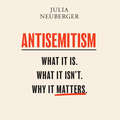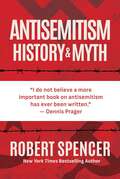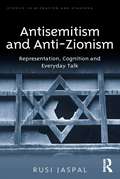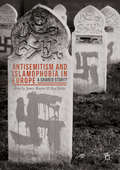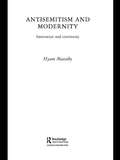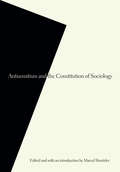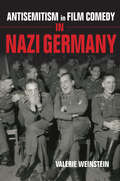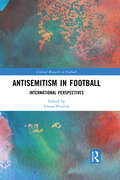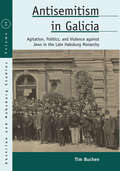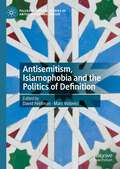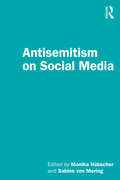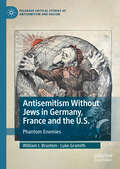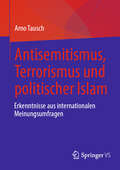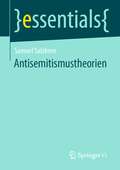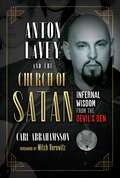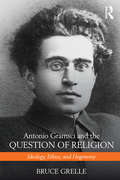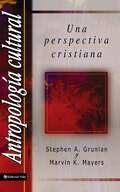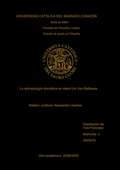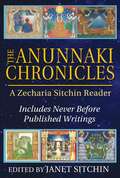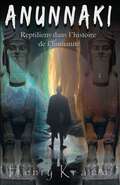- Table View
- List View
Antisemitism: What It Is. What It Isn't. Why It Matters
by Julia NeubergerThere has been a disturbing rise in antisemitism in Europe over the last fifteen years or so, with violent attacks on Jewish targets, increased verbal antisemitism, and an acceptability in many circles of what would hitherto have been condemned as outrageous antisemitic discourse. More recently, the Labour party have come under fire for engaging in antisemitic abuse. Yet despite the dramatic increase in debate and discussion around antisemitism, there is a general sense of confusion about what should and shouldn't be defined as antisemitism - and particularly around criticism of the State of Israel.In this urgently needed book, Rabbi Julia Neuberger uses contemporary examples, along with historical context, to unpack what constitutes antisemitism, building a powerful argument for why it is so crucial that we come to a shared understanding now, and exploring ways of dealing with it.
Antisemitism: What It Is. What It Isn't. Why It Matters
by Julia NeubergerThere has been a disturbing rise in antisemitism in Europe over the last fifteen years or so, with violent attacks on Jewish targets, increased verbal antisemitism, and an acceptability in many circles of what would hitherto have been condemned as outrageous antisemitic discourse. More recently, the Labour party have come under fire for engaging in antisemitic abuse. Yet despite the dramatic increase in debate and discussion around antisemitism, there is a general sense of confusion about what should and shouldn't be defined as antisemitism - and particularly around criticism of the State of Israel.In this urgently needed book, Rabbi Julia Neuberger uses contemporary examples, along with historical context, to unpack what constitutes antisemitism, building a powerful argument for why it is so crucial that we come to a shared understanding now, and exploring ways of dealing with it.
Antisemitism: History and Myth
by Robert SpencerWhy the ancient evil of antisemitism has returned—and how to counter it. &“Had we listened to Robert Spencer and taken heed twenty years ago or even ten years ago, the impact of the Islamists driven antisemitism would not have caught us by surprise. We would have had in place an institutional effort to counter it. &“Here is another opportunity to pay attention to his important work. Read this book!&” –Ayaan Hirsi AliThe Hamas attack upon Israel on October 7, 2023, was one of the most inhuman jihad attacks ever. The attackers gloried in their savagery and vied to outdo one another in cruelty. Yet despite—or perhaps because of—its brutality, that attack unleashed expressions of hatred for Jews that shocked those who assumed such hate was a thing of the past. Global public opinion turned sharply against Israel. One campus protester carried a sign calling for a &“Final Solution.&” Another published a video saying, &“Be glad—be grateful—that I&’m not just going out and murdering Zionists.&” Synagogues all over the US received bomb threats. Jews in Europe and the US were attacked. October 7 also led to a large-scale reappearance of claims about the Jews&’ secret power and malevolence. Claims that Jews are enemies of all that is good have become mainstream as they have not been since Hitler put a bullet in his brain. The record needs to be set straight for anyone who is willing to see the truth. Historian Robert Spencer does just that. He reveals the sources of today&’s Jew-hatred in pre-Christian paganism, Christianity, Islam, and national and international socialism, and rebuts the most common claims against Jews. The resurgence of antisemitism should worry everyone, Jewish and non-Jewish, who is concerned about the recurrence of one of the darkest chapters in human history. The world today is on the brink of returning to such barbarism. Antisemitism: History and Myth is an attempt to keep that from happening.
Antisemitism and Anti-Zionism: Representation, Cognition and Everyday Talk (Studies in Migration and Diaspora)
by Rusi JaspalAntisemitism and anti-Zionism are complex, delineable, yet inter-related social-psychological phenomena. While antisemitism has been described as an irrational, age-old prejudice, anti-Zionism is often represented as a legitimate response to a ’rogue state’. Drawing upon media and visual sources and rich interview data from Iran, Britain and Israel, Antisemitism and Anti-Zionism: Representation, Cognition and Everyday Talk examines the concepts of antisemitism and anti-Zionism, tracing their evolution and inter-relations, and considering the distinct ways in which they are manifested, and responded to, by Muslim and Jewish communities in Iran, Britain and Israel. Providing insights from social psychology, sociology and history, this interdisciplinary analysis sheds light on the pivotal role of the media, social representations and identity processes in shaping antisemitism and anti-Zionism. As such, this provocative book will be of interest to social scientists working on antisemitism, race and ethnicity, political sociology and political science, media studies and Middle Eastern politics.
Antisemitism and Islamophobia in Europe: A Shared Story?
by James Renton Ben GidleyThis is the first book to examine the relationship between European antisemitism and Islamophobia from the Crusades until the twenty-first century in the principal flashpoints of the two racisms. With case studies ranging from the Balkans to the UK, the contributors take the debate away from politicised polemics about whether or not Muslims are the new Jews. Much previous scholarship and public discussion has focused on comparing European ideas about Jews and Judaism in the past with contemporary attitudes towards Muslims and Islam. This volume rejects this approach. Instead, it interrogates how the dynamic relationship between antisemitism and Islamophobia has evolved over time and space. The result is the uncovering of a previously unknown story in which European ideas about Jews and Muslims were indeed connected, but were also ripped apart. Religion, empire, nation-building, and war, all played their part in the complex evolution of this relationship. As well as a study of prejudice, this book also opens up a new area of inquiry: how Muslims, Jews, and others have responded to these historically connected racisms. The volume brings together leading scholars in the emerging field of antisemitism-Islamophobia studies who work in a diverse range of disciplines: anthropology, history, sociology, critical theory, and literature. Together, they help us to understand a Europe in which Jews and Arabs were once called Semites, and today are widely thought to be on two different sides of the War on Terror.
Antisemitism and Modernity: Innovation and Continuity (Routledge Jewish Studies Series)
by Hyam MaccobyThe subject of anti-Semitism, not long ago thought to be a dead issue, has been revised due to the conflict between Israel and the Palestinians. Maccoby traces the now topical discussion of the origins of Anti-Semitism, and especially its development in the modern world. The key questions that are addressed include: How is it that this medieval prejudice proved so lasting and potent? Are the roots of anti-Semitism religious? If so, how do these roots differ in Christianity and Islam? By what means did it bridge the gap between medievalism and Enlightenment? How was it that many of the most respected Enlightenment figures (such as Voltaire) dedicated as they were to tolerance and pluralism, retained a virulent anti-Semitism? These questions, and many more, are dealt with as Maccoby explores the roots of the anti-Semitism, tracing it from its origins, and shows how it has changed in accordance with the shifting ideas of the modern world but without changing in its essence. Antisemitism and Modernity is essential reading for those with interests in the development of anti-Semitism, its manifestation in the current world and its future.
Antisemitism and the Constitution of Sociology
by Marcel StoetzlerModern antisemitism and the modern discipline of sociology not only emerged in the same period, but—antagonism and hostility between the two discourses notwithstanding—also overlapped and complemented each other. Sociology emerged in a society where modernization was often perceived as destroying unity and “social cohesion.” Antisemitism was likewise a response to the modern age, offering in its vilifications of “the Jew” an explanation of society’s deficiencies and crises. Antisemitism and the Constitution of Sociology is a collection of essays providing a comparative analysis of modern antisemitism and the rise of sociology. This volume addresses three key areas: the strong influence of writers of Jewish background and the rising tide of antisemitism on the formation of sociology; the role of antisemitism in the historical development of sociology through its treatment by leading figures in the field, such as Emile Durkheim, Talcott Parsons, and Theodor W. Adorno; and the discipline’s development in the aftermath of the Nazi Holocaust. Together the essays provide a fresh perspective on the history of sociology and the role that antisemitism, Jews, fascism, and the Holocaust played in shaping modern social theory.
Antisemitism in Film Comedy in Nazi Germany
by Valerie WeinsteinToday many Germans remain nostalgic about "classic" film comedies created during the 1930s, viewing them as a part of the Nazi era that was not tainted with antisemitism. In Antisemitism in Film Comedy in Nazi Germany, Valerie Weinstein scrutinizes these comic productions and demonstrates that film comedy, despite its innocent appearance, was a critical component in the effort to separate "Jews" from "Germans" physically, economically, and artistically. Weinstein highlights how the German propaganda ministry used directives, pre- and post-production censorship, financial incentives, and influence over film critics and their judgments to replace Jewish "wit" with a slower, simpler, and more direct German "humor" that affirmed values that the Nazis associated with the Aryan race. Through contextualized analyses of historical documents and individual films, Weinstein reveals how humor, coded hints and traces, absences, and substitutes in Third Reich film comedy helped spectators imagine an abstract "Jewishness" and a "German" identity and community free from the former. As resurgent populist nationalism and overt racism continue to grow around the world today, Weinstein’s study helps us rethink racism and prejudice in popular culture and reconceptualize the relationships between film humor, national identity, and race.
Antisemitism in Football: International Perspectives (Critical Research in Football)
by Emma PoultonThis book investigates the nature and prevalence of expressions of antisemitism within the context of football in Europe and beyond, as well as attempts to challenge and combat this problematic phenomenon. Drawing on empirical research, the book presents a series of case studies of countries in which both football and antisemitism have been prominent, including England, Italy, Germany, Holland, Poland, Argentina and Hungary. Each chapter explains the historical context of why antisemitism prevails in their country and their country’s football culture; considers those football clubs with a ‘Jewish’ heritage and identity (which tend to be the catalyst for antisemitic abuse); and critically examines the measures being taken in that country to tackle antisemitism in football by organisations including governing bodies, campaign groups, supporter groups and football clubs themselves. No other book has looked as deeply into this highly topical issue which continues to blight contemporary football. Antisemitism in Football is important reading for anybody with an interest in football, fan cultures, the sociology of sport, Jewish studies, antisemitism and other forms of racism and discrimination in society.
Antisemitism in Galicia: Agitation, Politics, and Violence against Jews in the Late Habsburg Monarchy (Austrian and Habsburg Studies #29)
by Tim BuchenIn the last third of the nineteenth century, the discourse on the “Jewish question” in the Habsburg crownlands of Galicia changed fundamentally, as clerical and populist politicians emerged to denounce the Jewish assimilation and citizenship. This pioneering study investigates the interaction of agitation, violence, and politics against Jews on the periphery of the Danube monarchy. In its comprehensive analysis of the functions and limitations of propaganda, rumors, and mass media, it shows just how significant antisemitism was to the politics of coexistence among Christians and Jews on the eve of the Great War.
Antisemitism in Galicia: Agitation, Politics, and Violence against Jews in the Late Habsburg Monarchy (Austrian and Habsburg Studies #29)
by Tim BuchenIn the last third of the nineteenth century, the discourse on the “Jewish question” in the Habsburg crownlands of Galicia changed fundamentally, as clerical and populist politicians emerged to denounce the Jewish assimilation and citizenship. This pioneering study investigates the interaction of agitation, violence, and politics against Jews on the periphery of the Danube monarchy. In its comprehensive analysis of the functions and limitations of propaganda, rumors, and mass media, it shows just how significant antisemitism was to the politics of coexistence among Christians and Jews on the eve of the Great War.
Antisemitism in Reader Comments: Analogies for Reckoning with the Past (Postdisciplinary Studies in Discourse)
by Matthias J. BeckerThis book examines the most frequent form of Jew-hatred: Israel-related antisemitism. After defining this hate ideology in its various manifestations and the role the internet plays in it, the author explores the question of how Israel-related antisemitism is communicated and understood through the language used by readers in below-the-line comments. Drawing on a corpus of over 6,000 comments from traditionally left-wing news outlets The Guardian and Die Zeit, the author examines both implicit and explicit comparisons made between modern-day Israel and both colonial Britain and Nazi Germany. His analyses are placed within the context of resurgent neo-nationalism in both countries, and it is argued that these instances of antisemitism perform a multi-faceted role in absolving guilt, re-writing history, and reinforcing in-group status. This book will be of interest not only to linguistics scholars, but also to academics in fields such as internet studies, Jewish studies, hate speech and antisemitism.
Antisemitism, Islamophobia and the Politics of Definition (Palgrave Critical Studies of Antisemitism and Racism)
by David Feldman Marc VoloviciThis book, the first to explore the politics of definitions from an interdisciplinary perspective, encourages readers to reconsider the value and limits of definitions in confronting antisemitism and Islamophobia. In recent years, definitions of antisemitism and Islamophobia have become central to the struggle to combat the hostility, harassment and discrimination experienced by Jews and Muslims. Yet these definitions have also provoked fierce controversy: critics have questioned whether they are fit for purpose, or have criticised them as unwelcome attempts to restrict freedom of expression. In this edited collection, historians, social scientists and philosophers reflect on definitions of antisemitism and Islamophobia in both the past and the present. Its contributors investigate the different historical contexts which have shaped definitions and examine their different political purposes and meanings, as well as addressing contemporary debates, and identifying ways for us to move beyond our current impasse. This book therefore provides a broad and new perspective from which to comprehend present day minority politics.
Antisemitism on Social Media
by Monika Hübscher and Sabine von MeringAntisemitism on Social Media is a book for all who want to understand this phenomenon. Researchers interested in the matter will find innovative methodologies (CrowdTangle or Voyant Tools mixed with discourse analysis) and new concepts (tertiary antisemitism, antisemitic escalation) that should become standard in research on antisemitism on social media. It is also an invitation to students and up-and-coming and established scholars to study this phenomenon further. This interdisciplinary volume addresses how social media with its technology and business model has revolutionized the dissemination of antisemitism and how this impacts not only victims of antisemitic hate speech but also society at large. The book gives insight into case studies on different platforms such as Twitter, Facebook, TikTok, YouTube, and Telegram. It also demonstrates how social media is weaponized through the dissemination of antisemitic content by political actors from the right, the left, and the extreme fringe, and critically assesses existing counter-strategies. People working for social media companies, policy makers, practitioners, and journalists will benefit from the questions raised, the findings, and the recommendations. Educators who teach courses on antisemitism, hate speech, extremism, conspiracies, and Holocaust denial but also those who teach future leaders in computer technology will find this volume an important resource.
Antisemitism Without Jews in Germany, France and the U.S.: Phantom Enemies (Palgrave Critical Studies of Antisemitism and Racism)
by William I. Brustein Luke GramithWhy does antisemitic messaging strike a chord in certain communities without Jews but fall flat in neighboring communities equally without Jews? This book focuses on antipathy towards Jews - expressed through successful electoral campaigns where a candidate or political party championed antisemitism - in communities located in three different nations where the Jewish population had virtually no history of interaction with the resident majority population of non-Jews. The cases are: the election of antisemitic deputies in the 1893 German Reichstag Elections from eastern Saxony; the election of a slate of antisemitic deputies to the French Chamber in 1898 from the southwestern French department of the Gers; and the significant proportion of votes for the antisemitic campaign of Gerald B. Winrod in the U.S. Senate Republican Party primary election in 1938 in Kansas. Each of these examples illustrates the existence of heightened levels of antisemitism in cases where few, if any, Jews had engagement with the majority population.
Antisemitismus, Terrorismus und politischer Islam: Erkenntnisse aus internationalen Meinungsumfragen
by Arno TauschAngesichts der unfassbaren Pogrome, die die Terrororganisation Hamas, beginnend mit dem 7. Oktober 2023, in Israel verübte, und angesichts der Welle des globalen Antisemitismus und der antijüdischen Gewalt, die seither über die Welt hereingebrochen ist, ist eine empirisch orientierte Analyse von Antisemitismus, Terrorismus und politischem Islam von absoluter Wichtigkeit. Die Beiträge in diesem Buch versuchen, basierend auf Meinungsumfragen, einen aktuellen und empirisch abgesicherten Beitrag über das Verhältnis von Antisemitismus, Terrorismus und politischem Islam zu präsentieren, der dem internationalen Forschungsstand entspricht. Alles deutet darauf hin, dass der Antisemitismus der sogenannten "gemäßigten Islamisten" die Verbreitung der Ideologie des brutalen Terrorismus erst ermöglicht und sogar in Mode gebracht hat.
Antisemitismustheorien (essentials)
by Samuel SalzbornDas Buch fasst die theoretischen Erkenntnisse der sozialwissenschaftlichen Antisemitismusforschung zusammen. Berücksichtigt werden dabei die Mikro-, die Meso- und die Makroebene, was psychologische, soziologische und politikwissenschaftliche/philosophische Ansätze umfasst. Dargestellt werden Fragen des Individuums und der antisemitischen Persönlichkeit, der sozialen Vermittlung in Kultur, Gesellschaft und Masse sowie der gesellschaftlichen, ökonomischen und politischen Strukturen.
Antitrinitarianism and Unitarianism in the Early Modern World
by Kazimierz Bem Bruce GordonThis collection offers an innovative and fresh interpretation of Antitrinitarian and rational dissent in the early modern world. The central themes focus on the fierce debates surrounding Antitrinitarianism and Unitarianism that emerged from the Reformation and the lived cultures of these dissenting movements. The chapters take an interdisciplinary approach addressing ideas in context, their reception and appropriation, and the diverse and often conflicting visions of Christianity. Drawing on previously unused sources, many from Eastern Europe and often in inaccessible languages, this book challenges our understanding of dissent as marginal and eccentric and places it at the center of contesting convictions about the nature of religious reform.
Anton LaVey and the Church of Satan: Infernal Wisdom from the Devil's Den
by Carl Abrahamsson• Includes never-before-published material from LaVey, including transcripts from his never-released &“Hail Satan!&” video • Shares in-depth interviews with intimate friends and collaborators, including LaVey&’s partner Blanche Barton, his son Xerxes LaVey, and current heads of the Church of Satan Peter Gilmore and Peggy Nadramia • Provides inside accounts of the Church of Satan and activities at the Black House, personal stories and anecdotes from the very colorful life of the Black Pope, and firsthand explanations of key principles of LaVey&’s philosophy With his creation of the infamous Church of Satan in 1966 and his bestselling book The Satanic Bible in 1969, Anton Szandor LaVey (1930-1997) became a controversial celebrity who basked in the attention and even made a successful career out of it. But who was Anton LaVey behind the public persona that so easily provoked Christians and others intolerant of his views? One of privileged few who spent time with the &“Black Pope&” in the last decade of his life, Carl Abrahamsson met Anton LaVey in 1989, sparking an &“infernally&” empowering friendship. In this book Abrahamsson explores what LaVey was really about, where he came from, and how he shaped the esoteric landscape of the 1960s. The author shares in-depth interviews with the notorious Satanist&’s intimate friends and collaborators, including LaVey&’s partner Blanche Barton, his son Xerxes LaVey, current heads of the Church of Satan Peter Gilmore and Peggy Nadramia, occult filmmaker Kenneth Anger, LaVey&’s personal secretary Margie Bauer, film collector Jack Stevenson, and film historian Jim Morton. Abrahamsson also shares never-before-published material from LaVey himself, including discussions between LaVey and Genesis P-Orridge and transcripts from LaVey&’s never-released &“Hail Satan!&” video. Providing inside accounts of the Church of Satan and activities at the Black House, this intimate exploration of Anton LaVey reveals his ongoing role in the history of culture and magic.
Antonio Gramsci and the Question of Religion: Ideology, Ethics, and Hegemony
by Bruce GrelleAntonio Gramsci and the Question of Religion provides a new introduction to the thought of Gramsci through the prisms of religious studies and comparative ethics. Bruce Grelle shows that Gramsci’s key ideas – on hegemony, ideology, moral reformation, "traditional" and "organic" intellectuals – were formulated with simultaneous considerations of religion and politics. Identifying Gramsci’s particular brand of Marxism, Grelle offers an overview of Gramsci’s approach to religion and applies it to contemporary debates over the role of religion and morality in social order and social change. This book is ideal for students and scholars interested in Gramsci, religion, and comparative ethics.
Antonio Vieira and the Luso-Brazilian Baroque
by Cohen Thomas Schwartz Stuart B.Preacher, politician, natural law theorist, administrator, diplomat, polemicist, prophetic thinker: Vieira was all of these things, but nothing was more central to his self-definition than his role as missionary and pastor. Articles in this issue were originally presented at a conference, “The Baroque World of Padre António Vieira: Religion, Culture and History in the Luso-Brazilian World,” Yale University, November 7–8, 1997, commemorating the three hundredth anniversary of Vieira’s death.
Antropología Cultural: Una perspectiva cristiana
by Stephen A. Grunlan Marvin K. MayersEl tema se presenta desde una perspectiva cristiana. Los autores, basándose en su amplia experiencia pastoral, misionera y académica, le ofrecen a usted una introducción a este tema y para la apreciación de las diversas culturas creadas por Dios. Algunos de los temas son antropología y misiones, comunicación verbal y no verbal, economía y tecnología, matrimonio y familia, grupos y comunidades, y religión.
La antropología dramática en Hans Urs Von Balthasar
by Francesco TosiEste trabajo presenta el corazón de la antropología balthasariana basada en el dinamismo de la relación siempre presente entre las dos libertades: la libertad de Dios y la libertad del hombre. Dicho dinamismo es dramático en la medida en que los sujetos implicados en la relación ejercitan su propia libertad uno en relación con el otro. De hecho solamente así es posible una existencia dramática y no trágica. Sólo en caso que no se entienda a Dios como lejano e inaccesible (el Totalemte Otro), sino como Quien ha entrado en la historia del hombre como hombre y se ha hecho compañero del hombre, sin que por ello cese de ser Sí mismo, será para la existencia humana drama y no tragedia. Entonces podemos afirmar junto con Balthasar que no hay otra dramática fuera de la teodramática. Al ilustrar los dos personajes del drama dentro de esta relación hemos seguido a nuestro autor en su doble y bipolar movimiento de pensamiento que realiza en su investigación in naturalibus, por así decirlo, hasta cuando la insuficiencia de dicha reflexión necesita de un cambio de prospectiva que se mueva desde Dios. Nos ocupamos entonces de la relación libertad finita-infinita como condición preliminar para el desarrollo del drama. La libertad finita está caracterizada por dos momentos estructurales: la posibilidad de disponer libremente de sí y la apertura universal. En razón de estos dos momentos inseparables el hombre experimenta una aparente contradicción de ser libre y al mismo tiempo en camino hacia la propia libertad: se mueve libremente a sí mismo, es responsable de su destino; al mismo tiempo experimenta su dependencia reencontrándose en un espacio ilimitado de realización, una tensión hacia el Absoluto que no es capaz de alcanzar con sus propias fuerzas y que no puede alcanzarlo con conseguir algún bien finito. A partir de esta condición en Balthasar surge el pensamiento límite de la autoapertura de la libertad infinita en relaci
The Anunnaki Chronicles: A Zecharia Sitchin Reader
by Janet Sitchin Zecharia SitchinAn insider’s look into the decades of research behind Zecharia Sitchin’s books as well as an in-depth overview of his theories and discoveries • Includes carefully selected chapters from the Earth Chronicles series as well as never-before-published letters, articles, and lectures • Each piece includes an introduction, offering context and insight into Sitchin’s passionate work and revealing the man behind the theories • Explains the genesis of The 12th Planet, the Anunnaki influences on the Sumerian civilization, the orbit of Nibiru, the prehistory of the Americas, the extraterrestrial origins of modern man, and much more What if the tales from the Old Testament and other ancient writings, such as those from Sumer, Babylon, Egypt, and Greece, were not myths or allegory but accounts of actual historical events? Known for his ability to read and interpret ancient Sumerian and Akkadian clay tablets, Zecharia Sitchin (1920-2010) took the words of our most ancient ancestors as fact and, through decades of meticulous research, showed that they revealed a coherent narrative about the true origins of humanity and civilization. Drawing both widespread interest and criticism, his Earth Chronicles series of books, beginning with The 12th Planet, detailed how humanity arose after the arrival of the Anunnaki (“those who from Heaven to Earth came”), alien “gods” who created modern man in their own image and imparted gifts of civilizing knowledge. Providing an insider’s look into the decades of research behind Zecharia Sitchin’s complete works as well as an in-depth overview of his theories, this collection includes carefully selected chapters from the Earth Chronicles series as well as never-before-published letters, articles, and lectures. We learn about the genesis of The 12th Planet in “The Book as a Story,” the Sumerians and their Anunnaki influences in “The Sudden Civilization,” the orbit of Nibiru in “UFOs, Pyramids, and the 12th Planet,” the prehistory of the Americas in “Cities Lost and Found,” the extraterrestrial origins of modern man in “The Cosmic Connection--DNA,” and much more. We get to read never-before-published lectures, culled from Sitchin’s decades of presentations, as well as the article that spurred the writing of There Were Giants Upon the Earth. Each piece includes an introduction by Sitchin’s niece, offering context and insight into Sitchin’s passionate work. These introductions reveal the man behind the theories, a world traveler known for his scholarship, dry humor, and precisely chosen words. If his theories are true, as Sitchin wholeheartedly believed, then this collection presents some of the most important knowledge we have of our origins and future.
ANUNNAKI: Reptiliens dans l’histoire de l’humanité
by Robinson FowlerIl y a beaucoup de cultures qui nous parlent de l’existence d’êtres Reptiliens, considérés comme des dieux: Les Anunnakis. Il y a beaucoup d’indices, de traces que ces êtres ont laissé dans notre histoire. Les anciens signalèrent et représentèrent ces dieux dans leurs peintures, leurs écrits, et surtout, leurs constructions, lesquelles sont impossibles à reproduire aujourd’hui. Leurs connaissances tant technologiques que de conscience de l’univers influencèrent notre histoire... même jusqu’à nos jours...

